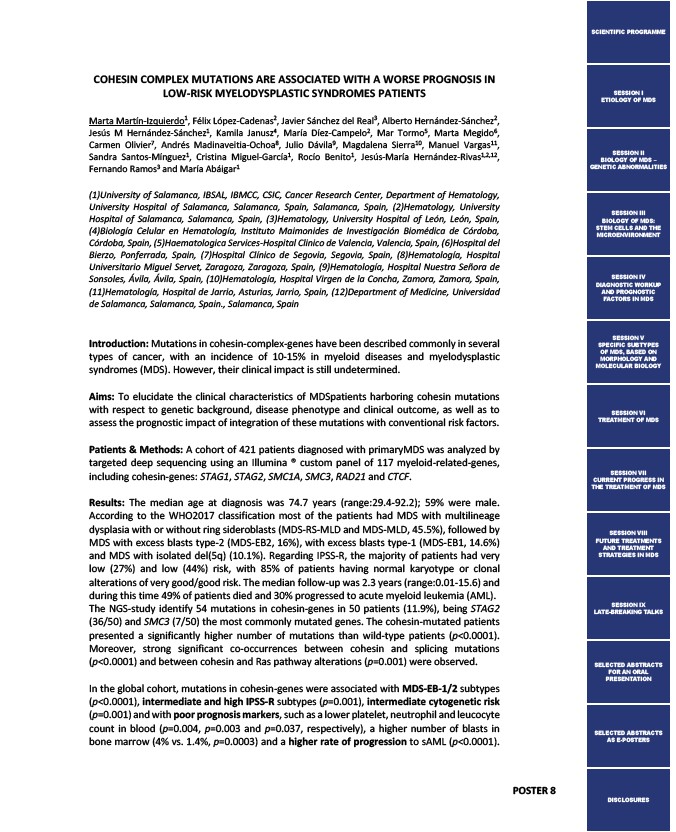
COHESIN COMPLEX MUTATIONS ARE ASSOCIATED WITH A WORSE PROGNOSIS IN
LOW-RISK MYELODYSPLASTIC SYNDROMES PATIENTS
Marta Martín-Izquierdo1, Félix López-Cadenas2, Javier Sánchez del Real3, Alberto Hernández-Sánchez2,
Jesús M Hernández-Sánchez1, Kamila Janusz4, María Díez-Campelo2, Mar Tormo5, Marta Megido6,
Carmen Olivier7, Andrés Madinaveitia-Ochoa8, Julio Dávila9, Magdalena Sierra10, Manuel Vargas11,
Sandra Santos-Mínguez1, Cristina Miguel-García1, Rocío Benito1, Jesús-María Hernández-Rivas1,2,12,
Fernando Ramos3 and María Abáigar1
(1)University of Salamanca, IBSAL, IBMCC, CSIC, Cancer Research Center, Department of Hematology,
University Hospital of Salamanca, Salamanca, Spain, Salamanca, Spain, (2)Hematology, University
Hospital of Salamanca, Salamanca, Spain, (3)Hematology, University Hospital of León, León, Spain,
(4)Biología Celular en Hematología, Instituto Maimonides de Investigación Biomédica de Córdoba,
Córdoba, Spain, (5)Haematologica Services-Hospital Clinico de Valencia, Valencia, Spain, (6)Hospital del
Bierzo, Ponferrada, Spain, (7)Hospital Clínico de Segovia, Segovia, Spain, (8)Hematología, Hospital
Universitario Miguel Servet, Zaragoza, Zaragoza, Spain, (9)Hematología, Hospital Nuestra Señora de
Sonsoles, Ávila, Ávila, Spain, (10)Hematología, Hospital Virgen de la Concha, Zamora, Zamora, Spain,
(11)Hematología, Hospital de Jarrio, Asturias, Jarrio, Spain, (12)Department of Medicine, Universidad
de Salamanca, Salamanca, Spain., Salamanca, Spain
I
ntroduction: Mutations in cohesin-complex-genes have been described commonly in several
types of cancer, with an incidence of 10-15% in myeloid diseases and myelodysplastic
syndromes (MDS). However, their clinical impact is still undetermined.
Aims: To elucidate the clinical characteristics of MDSpatients harboring cohesin mutations
with respect to genetic background, disease phenotype and clinical outcome, as well as to
assess the prognostic impact of integration of these mutations with conventional risk factors.
Patients & Methods: A cohort of 421 patients diagnosed with primaryMDS was analyzed by
targeted deep sequencing using an Illumina ® custom panel of 117 myeloid-related-genes,
including cohesin-genes: STAG1, STAG2, SMC1A, SMC3, RAD21 and CTCF.
Results: The median age at diagnosis was 74.7 years (range:29.4-92.2); 59% were male.
According to the WHO2017 classification most of the patients had MDS with multilineage
dysplasia with or without ring sideroblasts (MDS-RS-MLD and MDS-MLD, 45.5%), followed by
MDS with excess blasts type-2 (MDS-EB2, 16%), with excess blasts type-1 (MDS-EB1, 14.6%)
and MDS with isolated del(5q) (10.1%). Regarding IPSS-R, the majority of patients had very
low (27%) and low (44%) risk, with 85% of patients having normal karyotype or clonal
alterations of very good/good risk. The median follow-up was 2.3 years (range:0.01-15.6) and
during this time 49% of patients died and 30% progressed to acute myeloid leukemia (AML).
The NGS-study identify 54 mutations in cohesin-genes in 50 patients (11.9%), being STAG2
(36/50) and SMC3 (7/50) the most commonly mutated genes. The cohesin-mutated patients
presented a significantly higher number of mutations than wild-type patients (p<0.0001).
Moreover, strong significant co-occurrences between cohesin and splicing mutations
(p<0.0001) and between cohesin and Ras pathway alterations (p=0.001) were observed.
In the global cohort, mutations in cohesin-genes were associated with MDS-EB-1/2 subtypes
(p<0.0001), intermediate and high IPSS-R subtypes (p=0.001), intermediate cytogenetic risk
(p=0.001) and with poor prognosis markers, such as a lower platelet, neutrophil and leucocyte
count in blood (p=0.004, p=0.003 and p=0.037, respectively), a higher number of blasts in
bone marrow (4% vs. 1.4%, p=0.0003) and a higher rate of progression to sAML (p<0.0001).
POSTER 8
SCIENTIFIC PROGRAMME
SESSION I
ETIOLOGY OF MDS
SESSION II
BIOLOGY OF MDS –
GENETIC ABNORMALITIES
SESSION III
BIOLOGY OF MDS:
STEM CELLS AND THE
MICROENVIRONMENT
SESSION IV
DIAGNOSTIC WORKUP
AND PROGNOSTIC
FACTORS IN MDS
SESSION V
SPECIFIC SUBTYPES
OF MDS, BASED ON
MORPHOLOGY AND
MOLECULAR BIOLOGY
SESSION VI
TREATMENT OF MDS
SESSION VII
CURRENT PROGRESS IN
THE TREATMENT OF MDS
SESSION VIII
FUTURE TREATMENTS
AND TREATMENT
STRATEGIES IN MDS
SESSION IX
LATE-BREAKING TALKS
SELECTED ABSTRACTS
FOR AN ORAL
PRESENTATION
SELECTED ABSTRACTS
AS E-POSTERS
DISCLOSURES